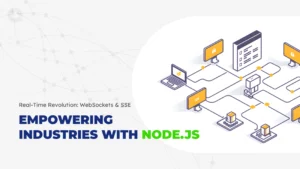
Recruiting the right talent for any organization is a critical process, and an applicant tracking system (ATS) can make this process smoother and more efficient. An ATS web application automates the hiring process by filtering and organizing job applications and resumes, enabling recruiters to screen, track and manage candidates more effectively. Building a complete ATS web application using Node.js can be a game-changer for any organization looking to streamline its recruitment process. In this blog post, we will guide you through the process of building a complete ATS web application using Node.js, explaining each step in detail.
Understanding ATS and its Components
An ATS system is designed to help recruiters manage the recruitment process, from posting job openings to hiring candidates. Its primary function is to automate the entire recruitment process and provide recruiters with tools to manage applications efficiently. The key components of an ATS system include:
1). Job Posting
The job posting component allows recruiters to create and post job vacancies on job boards or career sites. It enables them to define job titles, job descriptions, job qualifications, and other essential information related to the job.
2). Applicant Tracking
The applicant tracking component manages the entire applicant’s journey, from receiving the application to the final stage of hiring. It allows recruiters to filter and organize applications based on specific criteria, such as experience, education, skills, and more.
3). Resume Parsing
The resume parsing component is responsible for extracting essential data from resumes, such as contact details, work experience, education, and skills, and storing this data in a structured format.
4). Communication
The communication component enables recruiters to communicate with candidates through emails or other communication channels. It allows recruiters to schedule interviews, send automated emails, and manage communication history.
5). Reporting
The reporting component generates reports on key recruitment metrics, such as the number of applicants, time-to-hire, source of hire, and more. It provides recruiters with insights into the recruitment process and helps them make informed decisions.
These components work together to form a complete ATS system that enables recruiters to manage the recruitment process efficiently.
Setting up the Development Environment
To build an ATS web application using Node.js, we need to set up the development environment with the necessary software and tools. Here are the steps to set up the development environment:
1). Install Node.js
Node.js is a server-side JavaScript runtime that allows us to run JavaScript on the server. You can download the latest version of Node.js from the official website and install it on your machine.
2). Install NPM
NPM (Node Package Manager) is a package manager for Node.js that allows us to install and manage packages for our project. NPM comes bundled with Node.js, so you don’t need to install it separately.
3). Install a Code Editor
A code editor is a tool that allows us to write, edit, and debug code. There are many code editors available, such as Visual Studio Code, Sublime Text, Atom, and more. Choose the one that suits your requirements and install it.
4). Install MongoDB
MongoDB is a NoSQL database that we will use to store data for our ATS web application. You can download and install MongoDB from the official website.
Building the Backend of the ATS Web Application
The backend of an ATS web application handles server-side logic, database interaction, and other backend tasks. Here are the steps to build the backend of the ATS web application using Node.js:
1). Set up the server
We can set up the server using Node.js and Express.js. Express.js is a popular Node.js web framework that allows us to build web applications quickly. We can use the following command to create a new Express.js project:
$ npx express-generator --no-view ats-backend2). Set up the database
We can set up the database using MongoDB. We need to define the database schema and connect to the database from our Node.js application. We can use the following code to connect to the MongoDB database:
const mongoose = require('mongoose');
const connectDB = async () => {
try {
await mongoose.connect(process.env.MONGO_URI, {
useNewUrlParser: true,
useUnifiedTopology: true,
useCreateIndex: true,
useFindAndModify: false,
});
console.log('MongoDB connected');
} catch (error) {
console.error(error.message);
process.exit(1);
}
};
module.exports = connectDB;3). Implement user authentication and authorization
We can use Passport.js to implement user authentication and authorization. Passport.js is an authentication middleware for Node.js that supports various authentication strategies, such as local authentication, social authentication, and more. We can use the following code to implement user authentication using Passport.js:
const passport = require('passport');
const LocalStrategy = require('passport-local').Strategy;
const User = require('../models/User');
passport.use(
new LocalStrategy(
{
usernameField: 'email',
},
async (email, password, done) => {
try {
const user = await User.findOne({ email });
if (!user) {
return done(null, false, { message: 'Incorrect email or password.' });
}
const isMatch = await user.comparePassword(password);
if (!isMatch) {
return done(null, false, { message: 'Incorrect email or password.' });
}
return done(null, user);
} catch (error) {
return done(error);
}
}
)
);
passport.serializeUser((user, done) => {
done(null, user.id);
});
passport.deserializeUser(async (id, done) => {
try {
const user = await User.findById(id);
done(null, user);
} catch (error) {
done(error);
}
});
Building the Frontend of the ATS Web Application
The frontend of an ATS web application handles user interface design, client-side logic, and other frontend tasks. Here are the steps to build the frontend of the ATS web application using React.js:
1). Set up the client side
We can set up the client side using Create React App, which is a popular tool for creating React applications. We can use the following command to create a new React.js project:
2). Implement user interface design
We can use CSS and HTML to implement user interface design. There are many CSS frameworks available, such as Bootstrap, Materialize, and more. Choose the one that suits your requirements and import it into your project.
3). Make API calls to the backend
We can use Axios to make API calls to the backend. Axios is a popular HTTP client for Node.js and browser-based applications. We can use the following code to make API calls to the backend:
import axios from 'axios';
const API_BASE_URL = process.env.REACT_APP_API_BASE_URL;
const login = async (email, password) => {
try {
const response = await axios.post(`${API_BASE_URL}/auth/login`, {
email,
password,
});
return response.data;
} catch (error) {
throw new Error(error.response.data.message);
}
};
export { login };
Integrating the Components of the ATS Web Application
Once we have built the backend and frontend of the ATS web application, we need to integrate them to form a complete ATS system. Here are the steps to integrate the components of the ATS web application:
1). Create RESTful APIs
We need to create RESTful APIs for the frontend to communicate with the backend. We can use Express.js to create RESTful APIs. Here’s an example of how to create a RESTful API using Express.js:
const express = require('express');
const router = express.Router();
const auth = require('../middleware/auth');
const User = require('../models/User');
router.get('/users', auth, async (req, res) => {
try {
const users = await User.find().select('-password');
res.json(users);
} catch (error) {
console.error(error.message);
res.status(500).send('Server Error');
}
});
module.exports = router;2). Test the ATS web application
We need to test the ATS web application to ensure that it works seamlessly. We can use testing tools such as Mocha, Chai, and Supertest to test the ATS web application.
3). Deploy the ATS web application
We can deploy the ATS web application to a cloud hosting platform like Heroku. Heroku is a popular cloud hosting platform that supports various programming languages, including Node.js. We can use the following command to deploy the ATS web application to Heroku:
$ git push heroku masterConclusion
An ATS web application is a valuable tool for recruitment that helps streamline the hiring process. In this blog post, we have discussed the key components of an ATS system, the necessary software and tools required for building an ATS web application, and how to build a complete ATS web application using Node.js. We have also discussed how to set up the development environment, build the backend and frontend of the ATS web application, integrate the components of the ATS web application, test the ATS web application, and deploy the ATS web application to a cloud hosting platform like Heroku.
Building an ATS web application using Node.js may seem challenging, but it’s a rewarding experience. By following the steps outlined in this blog post, you can build your own ATS web application and customize it to suit your specific needs. Remember to test your ATS web application thoroughly and deploy it to a reliable cloud hosting platform to ensure that it runs smoothly.

Frequently asked questions
An ATS web application can be built using various programming languages, including Java, Python, and Node.js. In this blog post, we focus on building an ATS web application using Node.js.
Yes, you can use a different front-end framework other than React.js for your ATS web application. However, the steps for setting up the client side and implementing the user interface design may differ depending on the front-end framework you choose.
The time it takes to build an ATS web application using Node.js can vary depending on your level of experience with Node.js and web development. It could take anywhere from a few days to several weeks to build a complete ATS web application.






